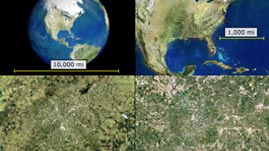Teachers' Domain - Digital Media for the Classroom and Professional Development
User: Preview

Source: McDougal Littell, a division of Houghton Mifflin Company. Developed by TERC, Inc., Cambridge, Massachusetts
Looking at an object or location at different scales, or scopes, provides the observer with a range of views — details are visible at a small scale while the overall picture is visible on a larger scale. In this combination of satellite images and animation from MacDougal Littell/TERC, see what one place on Earth looks like at different scales.
In science, the study of an object or area at different scales can provide very different sets of information. For example, to study a fly on a small scale, you could use a microscope to gain information about its cells. However, you couldn't determine how one body part relates to the rest of the fly, what the fly eats, or how it interacts with its environment. To gain such understandings, you would have to study the fly on a larger scale.
An instrument such as a microscope makes it possible to study objects in detail, but not to see the big picture. The greater the magnification power of the microscope, the smaller the field of view. Essentially, area is sacrificed for detail. It would not make sense to use a microscope to study something large-scale, such as global weather patterns. To study Earth on a global scale, a very wide field of view, such as that provided by orbiting satellites, is needed.
The universe is composed of matter ranging in size from the huge to the miniscule. For example, the diameter of the Sun is about 1.4 million kilometers (900,000 miles), and the diameter of a grain of sand is about 1 millimeter (0.04 inch). Even more extreme, the diameter of our galaxy is about 100,000 light-years (one light-year is equal to about 9.5 trillion kilometers, or 5.9 trillion miles). In contrast, the diameter of an atom is about 1 billionth of a meter (3 billionths of a foot). In order to gain a more complete understanding of the physical world, scientists study the universe at all of these different scales.
In working with this vast range of sizes and distances in nature, scientists often use orders of magnitude — powers of ten. With this scientific notation, it is possible to simplify long numbers into more manageable form, and it becomes easier to compare numbers. For example, instead of writing the distance of one light-year as 9.5 trillion kilometers or 9,500,000,000,000 kilometers, it can be written as 9.5x1012 kilometers. Similarly, instead of writing very small numbers such as 1 billionth of a meter as 0.000000001 meters, it can be written as 1x10-9 meters.
 Loading Standards
Loading Standards Teachers' Domain is proud to be a Pathways portal to the National Science Digital Library.
Teachers' Domain is proud to be a Pathways portal to the National Science Digital Library.
